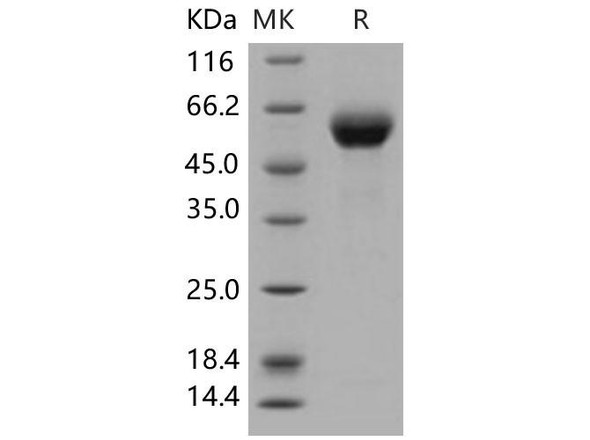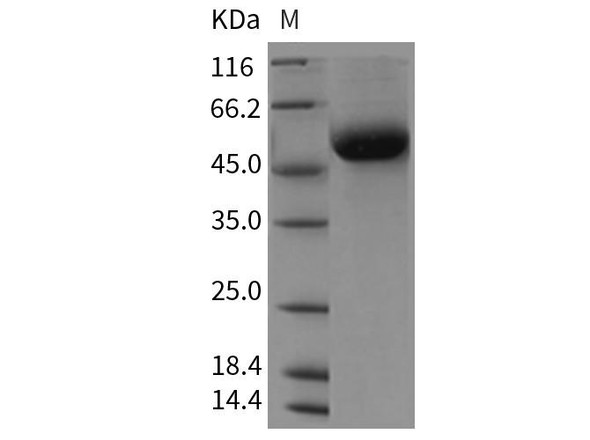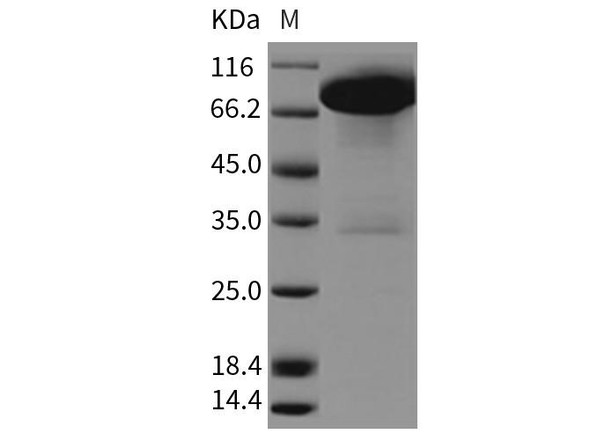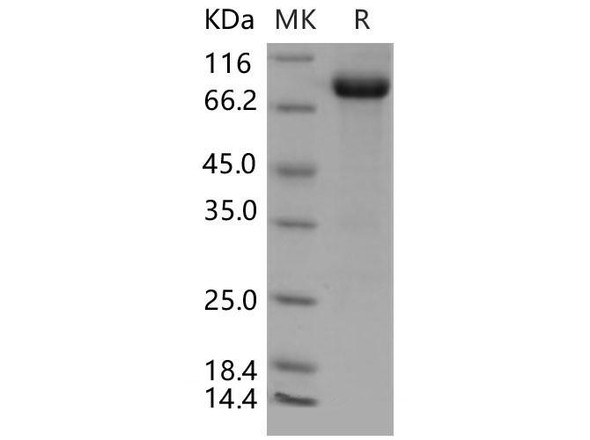Description
| Product Name: | Human DDR1 Recombinant Protein |
| Product Code: | RPPB2497 |
| Size: | 5µg |
| Species: | Human |
| Target: | DDR1 |
| Synonyms: | Discoidin Domain Receptor Tyrosine Kinase 1, CD167 Antigen-Like Family Member A, Protein-Tyrosine Kinase RTK-6, Mammary Carcinoma Kinase 10, Tyrosine-Protein Kinase CAK, Cell Adhesion Kinase, Tyrosine Kinase DDR, EC 2.7.10.1, EDDR1, NTRK4, PTK3A, HGK2, RTK6, TRKE, CAK, NEP, Neurotrophic Tyrosine Kinase, Receptor, Type 4, Discoidin Domain Receptor Family, Member 1, Epithelial Discoidin Domain Receptor 1, Discoidin Receptor Tyrosine Kinase, PTK3A Protein Tyrosine Kinase 3A, Neuroepithelial Tyrosine Kinase, Protein-Tyrosine Kinase 3A, CD167a Antigen, EC 2.7.10, MCK-10, CD167, MCK10, TRK E, PTK3, DDR. |
| Source: | Sf9 Insect cells |
| Physical Appearance: | Sterile Filtered colorless solution. |
| Formulation: | DDR1 protein solution (0.5mg/ml) contains Phosphate Buffered Saline (pH 7.4) and 10% glycerol. |
| Stability: | Store at 4°C if entire vial will be used within 2-4 weeks. Store, frozen at -20°C for longer periods of time.�For long term storage it is recommended to add a carrier protein (0.1% HSA or BSA).�Avoid multiple freeze-thaw cycles. |
| Purity: | Greater than 90.0% as determined by SDS-PAGE. |
| Amino Acid Sequence: | DMKGHFDPAK CRYALGMQDR TIPDSDISAS SSWSDSTAAR HSRLESSDGD GAWCPAGSVF PKEEEYLQVD LQRLHLVALV GTQGRHAGGL GKEFSRSYRL RYSRDGRRWM GWKDRWGQEV ISGNEDPEGV VLKDLGPPMV ARLVRFYPRA DRVMSVCLRV ELYGCLWRDG LLSYTAPVGQ TMYLSEAVYL NDSTYDGHTV GGLQYGGLGQ LADGVVGLDD FRKSQELRYV WPGYDYVGWS NHSFSSGYVE MEFEFDRLRA FQAMQVHCNN MHTLGARLPG GVECRFRRGP AMAWEGEPMR HNLGGNLGDP RARAVSVPLG GRVARFLQCR FLFAGPWLLF SEISFISDVV NNSSPALGGT FPPAPWWPPG PPPTNFSSLE LEPRGQQPVA KAEGSPTALE PKSCDKTHTC PPCPAPELLG GPSVFLFPPK PKDTLMISRT PEVTCVVVDV SHEDPEVKFN WYVDGVEVHN AKTKPREEQY NSTYRVVSVL TVLHQDWLNG KEYKCKVSNK ALPAPIEKTI SKAKGQPREP QVYTLPPSRD ELTKNQVSLT CLVKGFYPSD IAVEWESNGQ PENNYKTTPP VLDSDGSFFL YSKLTVDKSR WQQGNVFSCS VMHEALHNHY TQKSLSLSPG KHHHHHH |
Discoidin Domain Receptor Tyrosine Kinase 1 (DDR1) is a transmembrane glycoprotein which is a part of the discoidin-like domain containing subfamily of receptor tyrosine kinases. DDR1 functions as cell surface receptor for fibrillar collagen and regulates cell attachment to the extracellular matrix, remodeling of the extracellular matrix, cell migration, differentiation, survival and cell proliferation. DDR1 is expressed in epithelial cells, mainly in the kidney, lung, gastrointestinal tract, and brain and is significantly overexpressed in several human tumors.
DDR1 Human Recombinant produced in Sf9 Baculovirus cells is a single, glycosylated polypeptide chain containing 636 amino acids (21-417a.a.) and having a molecular mass of 71.0kDa (Molecular size on SDS-PAGE will appear at approximately 70-100kDa).DDR1 is expressed with a 239 amino acid hIgG-His tag at C-Terminus and purified by proprietary chromatographic techniques.
| UniProt Protein Function: | DDR1: Tyrosine kinase that functions as cell surface receptor for fibrillar collagen and regulates cell attachment to the extracellular matrix, remodeling of the extracellular matrix, cell migration, differentiation, survival and cell proliferation. Collagen binding triggers a signaling pathway that involves SRC and leads to the activation of MAP kinases. Regulates remodeling of the extracellular matrix by up-regulation of the matrix metalloproteinases MMP2, MMP7 and MMP9, and thereby facilitates cell migration and wound healing. Required for normal blastocyst implantation during pregnancy, for normal mammary gland differentiation and normal lactation. Required for normal ear morphology and normal hearing. Promotes smooth muscle cell migration, and thereby contributes to arterial wound healing. Also plays a role in tumor cell invasion. Phosphorylates PTPN11. Interacts (via PPxY motif) with WWC1 (via WW domains) in a collagen-regulated manner. Forms a tripartite complex with WWC1 and PRKCZ, but predominantly in the absence of collagen. Interacts (tyrosine phosphorylated) with SHC1. Interacts with SRC. Interacts with MYH9. Interacts with CDH1. Interacts with PTPN11. Interacts with NCK2. Detected in T-47D, MDA-MB-175 and HBL-100 breast carcinoma cells, A-431 epidermoid carcinoma cells, SW48 and SNU-C2B colon carcinoma cells and Hs 294T melanoma cells. Expressed at low levels in most adult tissues and is highest in the brain, lung, placenta and kidney. Lower levels of expression are detected in melanocytes, heart, liver, skeletal muscle and pancreas. Abundant in breast carcinoma cell lines. In the colonic mucosa, expressed in epithelia but not in the connective tissue of the lamina propria. In the thyroid gland, expressed in the epithelium of the thyroid follicles. In pancreas, expressed in the islets of Langerhans cells, but not in the surrounding epithelial cells of the exocrine pancreas. In kidney, expressed in the epithelia of the distal tubules. Not expressed in connective tissue, endothelial cells, adipose tissue, muscle cells or cells of hematopoietic origin. Belongs to the protein kinase superfamily. Tyr protein kinase family. Insulin receptor subfamily. 5 isoforms of the human protein are produced by alternative splicing. |
| UniProt Protein Details: | Protein type:EC 2.7.10.1; Membrane protein, integral; Protein kinase, TK; Kinase, protein; Protein kinase, tyrosine (receptor); TK group; DDR family Chromosomal Location of Human Ortholog: 6p21.3 Cellular Component: extracellular space; plasma membrane; receptor complex Molecular Function:collagen binding; protein binding; transmembrane receptor protein tyrosine kinase activity Biological Process: cell adhesion; extracellular matrix organization and biogenesis; protein amino acid autophosphorylation; smooth muscle cell migration |
| NCBI Summary: | Receptor tyrosine kinases play a key role in the communication of cells with their microenvironment. These kinases are involved in the regulation of cell growth, differentiation and metabolism. The protein encoded by this gene belongs to a subfamily of tyrosine kinase receptors with homology to Dictyostelium discoideum protein discoidin I in their extracellular domain, and that are activated by various types of collagen. Expression of this protein is restricted to epithelial cells, particularly in the kidney, lung, gastrointestinal tract, and brain. In addition, it has been shown to be significantly overexpressed in several human tumors. Alternatively spliced transcript variants encoding different isoforms have been described for this gene. [provided by RefSeq, Feb 2011] |
| UniProt Code: | Q08345 |
| NCBI GenInfo Identifier: | 729008 |
| NCBI Gene ID: | 780 |
| NCBI Accession: | Q08345.1 |
| UniProt Secondary Accession: | Q08345,Q14196, Q16562, Q2L6H3, Q4LE50, Q5ST11, Q5ST12 Q6NSK4, Q9UD35, B5A975, B5A976, B7Z2K0, |
| UniProt Related Accession: | Q08345 |
| Molecular Weight: | 99,064 Da |
| NCBI Full Name: | Epithelial discoidin domain-containing receptor 1 |
| NCBI Synonym Full Names: | discoidin domain receptor tyrosine kinase 1 |
| NCBI Official Symbol: | DDR1�� |
| NCBI Official Synonym Symbols: | CAK; DDR; NEP; HGK2; PTK3; RTK6; TRKE; CD167; EDDR1; MCK10; NTRK4; PTK3A�� |
| NCBI Protein Information: | epithelial discoidin domain-containing receptor 1 |
| UniProt Protein Name: | Epithelial discoidin domain-containing receptor 1 |
| UniProt Synonym Protein Names: | CD167 antigen-like family member A; Cell adhesion kinase; Discoidin receptor tyrosine kinase; HGK2; Mammary carcinoma kinase 10; MCK-10; Protein-tyrosine kinase 3A; Protein-tyrosine kinase RTK-6; TRK E; Tyrosine kinase DDR; Tyrosine-protein kinase CAK; CD_antigen: CD167a |
| Protein Family: | Epithelial discoidin domain-containing receptor |
| UniProt Gene Name: | DDR1�� |
| UniProt Entry Name: | DDR1_HUMAN |










